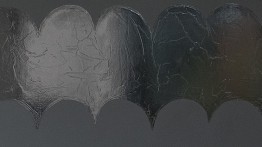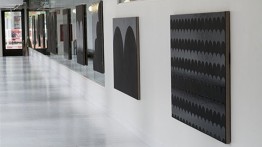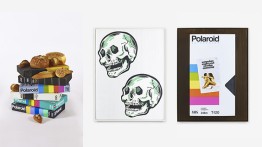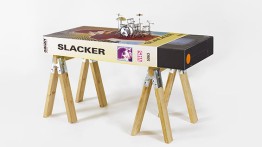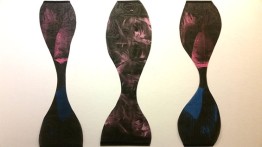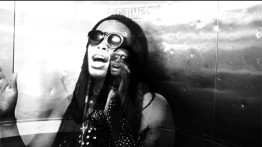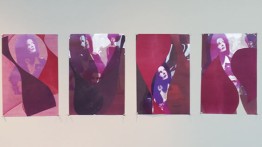Senior Snapshots 2016: School of Art
POSTED ON: May 3, 2016
In the second installment of our annual look at graduates of the three schools, we turn to the School of Art [see parts one and three]. This year's featured graduating seniors make art that, in strikingly different ways, relates to each artist's responses to and involvement with music. Christian Charles, Olivia Drusin and Willie Stewart talked to us about their experiences at Cooper, what they plan to do after graduation and the ways that music informed their art.
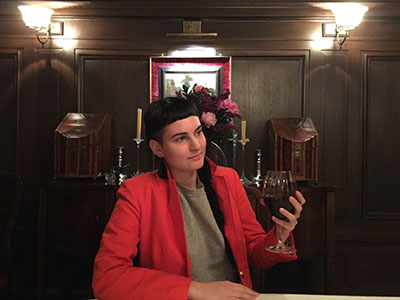
Olivia Drusin keeps an 8-inch-high statue of Elvis Presley on a shelf in her studio. She cast the finely detailed piece in bronze. It serves as a succinct and all together appropriate symbol for the senior art student’s greatest interests—music and art.
“A lot of my work came out of my involvement in a DIY music scene,” she says. “Sophomore year is hard because you don’t get any assignments. It’s always the moment when people decide the kinds of things they want to make, and so I was trying to think about ways to marry my interest in music and concepts in art.”
Her musical life has been a varied one: from singing with an a capella group in high school to performing her own songs solo to touring as the lead vocalist for the band Bluffing. She’s a fan of Ella Fitzgerald singing Cole Porter, has tried to copy Slayer guitar riffs, and calls Frank Sinatra “great.” In short, she’s catholic in her musical tastes and influences. All this might account for the title of her senior show, Elvis in the Living Room, a display of her black monochrome canvases in the Foundation Building’s colonnade.
The paintings are black-on-black images, often made up of shapes, commonly arches, variously arranged and at different depths in relation to the viewer. It’s as if she had imagined a camera pulling away for an aerial view at one moment, and focusing on a detail at another. The work is arduously constructed: She treats the linen surface with gesso and then sands it many times until she gets the texture and tones she’s looking for. She uses the same concentration of black pigment but in different media to get the subtle gradation in color.
Olivia arrived at this body of work through a lot of trial and error. She started by painting enamel on swatches of leather, but eventually abandoned that approach. She discovered, though, that she liked working with those materials. She began to make landscapes that she says looked like “underwater places with lots of weird foliage and hills." Unsatisfied, she threw those out and made sculptural paintings out of industrial sheet latex. “Using that as a painting surface meant that nothing I’d put on the surface would be absorbed, so I’d get these really amazing mirrored finishes. Those looked really great.” But there was one major problem: They all self-destructed. She eventually decided that she was making her practice unnecessarily difficult: There was no reason not to try to create similar surfaces on canvas.
“It was difficult for me to figure out both the technical aspect of what I was doing and the formal elements of the composition. So I got these forms from art history. This form or this kind of shape is something that appears a lot,” Olivia says. “I was thinking about minimalism and how a cube is just a cube, and you’re not allowed to project anything else into that and it’s just very formal and very face value, the systems are very rigid. My systems are also very rigid, but I wanted to choose a form you could relate to, bodily. They’re still very absolute icons but there’s more room for play.”
Olivia, who is a native New Yorker, learned about The Cooper Union from one of her high school art teachers who herself had attended Cooper. “When I was talking to her about wanting to going to art school, she really helped me. Otherwise, no one knew what I was supposed to do.” At Cooper, she says, she felt much freer to experiment with her work than she did in high school. “The art school is basically structured like graduate school, and to be so young and given so much freedom really prepares you well for whatever your next step is because it really gives you the room to succeed or to fail.”
“Since there are no specific tracks to be on,” Olivia says, “no two people are doing the same thing.” She credits her fellow students with making the dialogue at Cooper particularly engaging—and that she says is because everyone is free to work in ways that suit them.
Her colleague, Willie Stewart (see below), is a case in point: His work is more of what she calls “pop sculpture” and formally looks nothing like Olivia’s. But the two, who collaborated on the exhibition Six Flags Part II and a video for Bluffing, found that they were wrestling with the same questions about how music and art communicate differently. “A lot of the ways we think about counter culture completely aligned. We bonded over music. Our work definitely doesn’t look similar, but having that background…it was weird to see the threads and connections.”
After graduation, Olivia plans to keep working for the painter Emily May Smith while continuing to paint herself. She continues to think about the relationship between music and art, and how while related, the two require different types of engagement. “I think certain things like poetry and making music and painting all work the same parts of your brain,” she says. “I think music is definitely the most direct way to communicate in terms of that realm of things. It’s the most emotionally affected and affecting.” She concludes that “no matter what art form you do, you’re putting pieces of yourself out into the world and that’s emotionally exhausting. But it’ so much harder to do that on paper or in a picture or an image than it is to do it in a way as a listener. You feel like you’re directly involved.”
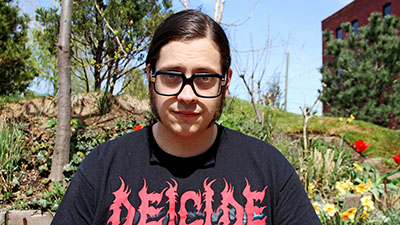 Having grown up in Gallatin, Tennessee as the son and grandson of motorcycle gang members, Willie Stewart’s art constantly wrestles with the personal implications of geography and history, much of it violent.
Having grown up in Gallatin, Tennessee as the son and grandson of motorcycle gang members, Willie Stewart’s art constantly wrestles with the personal implications of geography and history, much of it violent.
His interest as an artist, he says, is the ways we fabricate an identity for ourselves: No matter how contrived the signifiers may be—he uses the teenage boy who grows his hair long while listening to Metallica in his bedroom—they are all adopted with utter sincerity. “What I think about is when a true moment happens in your life, which you’ve created in sincerity, is ironic to another person. I’m interested in that,” he says. “I’m looking at this in my life: This is sincere, it seems ironic, it seems like a trope of kitsch or camp but the thing is I can’t get out of that, and I don’t want to get out of that. Because I think there’s something to explore within the sincerity of a subcultural identity.”
His work transforms detritus of late 20th century life into totems: VHS tapes, wood paneling (the grain detail hand-painted with astonishing verisimilitude), car fresheners, and in a nod to bikers’ life, long braids. They appear in his work as stand-ins for bell pulls, electrical cords and in one case, a noose.
Willie, who is 33, has spent much of his life as a musician, touring for many years, and he continues to work out his ideas by writing lyrics. On one occasion while driving his band in the middle of the night, he says, he was struck by an exchange he heard on George Noory’s famed overnight radio show, Coast to Coast AM. Noory’s guest that night was Alex Collier, who talked about his experiences with beings from the Andromeda constellation. He mentioned that they had given him one piece of parting advice: The love you withhold is the pain that you carry lifetime after lifetime.
The line stuck with Willie, who eventually used it as the title of a powerful and haunting installation he built. “The Love You Withhold Is the Pain That You Carry” is predicated on the subculture he grew up with, the world of Southern bikers. Viewers enter to follow an implied narrative about a boy and his family. The initial image is of a digitally woven tapestry with a photograph of a young couple and three children. “I see a lot of pain, and I see a lot of devilish desire in certain parts of that photo—and I’m attracted to the classical triangular composition of it.” The image was part of Stewart’s grandmother’s collection of photographs, a collection he used to mine for many of his art works. In the next rooms, Scotty, the young boy, appears in various scenarios of humiliation—a figure standing in a corner with his pants lowered to his ankles; a photograph of his behind with a flyswatter pressed against his skin.
More recently he made what he calls “gestures.” There was “All My Friends Are Dreamers Now,” for which he bought a human skull and ground it in a mortar and pestle, and scattered the resulting dust on the ground. Another piece found Willie making 55 gallons of LSD and putting it in a drum; he entitled it “The Problem.” This last was done for a Cooper class. “Where else could you do that?” he says, with a deep and sudden laugh.
Willie, a transfer student from the Watkins School of Art in Nashville who will attend Yale to earn an MFA in sculpture, says going to Cooper has been critical to his development as an artist. “You can liken the school’s pedagogical model to grad school because it’s a free model. There’s nothing to hide behind. When there’s no prompt, it becomes the animal instinct, what Dennis Adams would call the primal scene, and in the primal scene you create the vernacular, and you make your own image and there are not many schools that do that.”
He says that the freedom to take risks also came with a lot of guidance from the faculty, “who in a lot of ways are renegades. I mean, they’re like a motorcycle gang in themselves. That’s why I love them. I feel like I came out of one brotherhood into another one. They were able to take a guy with basement aesthetics—that’s what they always say about my work—and now I’m going to Yale and getting an MFA.”
His most recent work, an exhibition entitled “House on Fascination Street,” can be seen at Motel Gallery from April 30 to May 22. The Creators Project calls it, "a blast."
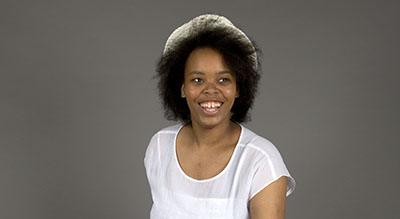 Christian Charles’ childhood in Syracuse, New York was steeped in dance and music. “My father was a radio broadcaster who owned two music stations, and my mom curated at galleries and taught dance—the Dunham technique. I grew up dancing and started when I was two,” she says. That background figures prominently in the artwork Christian made while a student at Cooper, work that features movement whether in the shapes and layers of her collages or in her performance for her final show. “I have to have a theatrical sense in my work,” she says.
Christian Charles’ childhood in Syracuse, New York was steeped in dance and music. “My father was a radio broadcaster who owned two music stations, and my mom curated at galleries and taught dance—the Dunham technique. I grew up dancing and started when I was two,” she says. That background figures prominently in the artwork Christian made while a student at Cooper, work that features movement whether in the shapes and layers of her collages or in her performance for her final show. “I have to have a theatrical sense in my work,” she says.
As a child, Christian took up to eight dance classes a day. At the same time, she was always attracted to drawing, particularly with charcoal, and had a love for graphic design. While attending the Jamesville-DeWitt High School, just outside of the Syracuse city limits, she became self-conscious about her body. “I didn’t have the figure that dancers are supposed to have, the ballerina body,” she says. "I decided to focus on drawing.” She won an art contest sponsored by Scholastic and decided that she wanted to study art in New York, hoping to live with her grandmother in Jamaica, Queens.
She first learned of Cooper from an aunt. “Really being in New York was my main goal; I didn’t know about Cooper. It’s seriously so incognito.” As it turned out, though, her aunt’s suggestion was a good one: Sshe met Prof. Lisa Lawley at a portfolio review held at the Rochester Institute of Technology. “She said, ‘We need you at Cooper.’ So I applied. One of my high school art teachers, Carlos Benedict, had gone to Cooper, and he let me work on the home test in class. When I got in, my mom said, 'You’re going.' And I said, 'Okay, let’s do this.'”
Prof. Lawley turned out to be a central figure in Christian’s Cooper education: Christian took drawing classes and an independent study with Prof. Lawley. During her junior year, Christian traveled to Berlin to study silkscreen, drawing and performance. When she returned to New York, she says, her artwork was “more refined and sophisticated like it was meant to be in a gallery.” In some ways, though, that refinement stymied her creativity. Prof. Lawley helped Christian get back into maker mode: “She gave me confidence. Sometimes I get into a generic design mindset, and when I got back from doing the exchange program in Berlin for six months, she said, ‘We need to make you get back to the nitty gritty, back to that messy mindset.’”
Christian loved the school from the start, and forged friendships that she thinks wouldn’t have been possible in larger, less intense programs. Although sophomore year is often thought to be a challenging one in the School of Art because students must make work of their own choosing with no prompts from professors, Christian found the freedom exhilarating. “I could play all the time,” as she puts it, and did a lot of her work that year in the print shop. Known for dancing in the halls of the Foundation Building to relieve stress, Christian also made sound works as part of her art practice.
Some of her most recent work was done on needlework canvas that the local Ukranian craft store, Surma, had donated to Prof. Cara Di Edwardo, who then gave it to Christian. She used the flexible but sturdy material to fashion a set of curved shapes at once suggestive of hips, waves, breasts and hourglasses. Christian, a confident, garrulous woman who seems to know everyone on campus, created the collages as part of her ongoing investigation of the ways that body parts are variously fetishized or rejected in different eras.
Christian is an unabashed lover of old school pop culture: Hollywood movies of the 1940s and ‘50s, the Broadway star Pearl Bailey, R and B singer Marvin Gaye, and the 1960s leading man Omar Sharif. “I am obsessed with classic films and classic stars—I’m a rom-com junkie. And I was thinking about these iconic women who were in the spotlight all the time,” she says of movie stars like Sophia Loren and Audrey Hepburn. “What if they were black? What would they look like black? I still love them for the goddesses they are. But seeing them in that context, I just laughed. I found it very comical.”
That question led to Christian’s series called Presence, silkscreen collages in which white film stars of the Golden Age of Hollywood are imagined as black women. Those works—with titles like Grace Curly and Natalie Hood—represent Christian’s engagement with contemporary discourse on race, art making and body image.
Surprisingly, she says, the role of race in her art was never directly discussed by her classmates or professors until this last semester of college. “People tried to avoid the conversations. They valued the process rather than the concept behind my work—it was too loaded or something. But I’m really proud of Cooper right now because Katie Pe Bonito founded a discussion group related to race called the Crit Club for Students of Color, and this semester the School of Art had its first class related to race and art, Kalia Brooks's Contemporary Art Issues. Having grown up in what she calls a “bougie background,” she initially hadn’t intended race to be present in her work, but now, she says, “I’m fully understanding how to present race in my work and how to understand it. How I looked at race through my eyes, I didn’t really see it as a problem, but hearing it from companions, I gained further understanding about different aspects of black culture and I wanted to help attest to that and support that.”
Christian, who will be attending the Glasgow School of Art to earn her MFA in Studio Art with a concentration in video and performance, decided to improvise a performance for her final show, which he gave the three-part title of “36-24-36, Feminine Essence, Betrayed by the Booty.” But when she saw how many people had arrived, she started to panic. “I didn’t know what I was going to do. I just didn’t realize how much love and support I had throughout this community,” she says.
Photograph of Olivia Drusin by Madeleine Drusin. Photo of Willie Steward by Yael Krevsky. Photo of Christian Charles by Larissa Gilbert.


